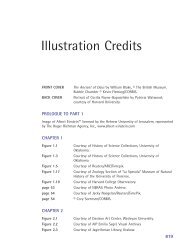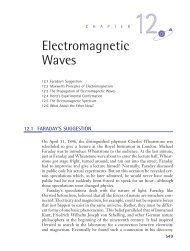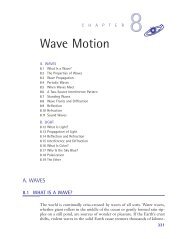Chapter 9: Einstein and Relativity Theory (319 KB) - D Cassidy Books
Chapter 9: Einstein and Relativity Theory (319 KB) - D Cassidy Books
Chapter 9: Einstein and Relativity Theory (319 KB) - D Cassidy Books
You also want an ePaper? Increase the reach of your titles
YUMPU automatically turns print PDFs into web optimized ePapers that Google loves.
3637_<strong>Cassidy</strong>TX_09 6/14/02 12:08 PM Page 410<br />
410 9. EINSTEIN AND RELATIVITY THEORY<br />
to President Roosevelt, warning that it might be possible to make an<br />
“atomic bomb,” for which the Germans had the necessary knowledge. (It<br />
was later found that they had a head-start on such research, but failed.) After<br />
World War II, <strong>Einstein</strong> devoted much of his time to organizations advocating<br />
world agreements to end the threat of nuclear warfare. He spoke<br />
<strong>and</strong> acted in favor of the founding of Israel. His obstinate search to the end<br />
for a unified field theory was unsuccessful; but that program, in more modern<br />
guise, is still one of the great frontier activities in physics today. Albert<br />
<strong>Einstein</strong> died in Princeton on April 18, 1955.<br />
9.3 THE RELATIVITY PRINCIPLE<br />
Compared with other theories discussed so far in this book, <strong>Einstein</strong>’s theory<br />
of relativity is more like Copernicus’s heliocentric theory than Newton’s<br />
universal gravitation. Newton’s theory is what <strong>Einstein</strong> called a “constructive<br />
theory.” It was built up largely from results of experimental<br />
evidence (Kepler, Galileo) using reasoning, hypotheses closely related to<br />
empirical laws, <strong>and</strong> mathematical connections. On the other h<strong>and</strong>, Copernicus’<br />
theory was not based on any new experimental evidence but primarily<br />
on aesthetic concerns. <strong>Einstein</strong> called this a “principle theory,” since<br />
it was based on certain assumed principles about nature, of which the deduction<br />
could then be tested against the observed behavior of the real world.<br />
For Copernicus these principles included the ideas that nature should be<br />
simple, harmonious, <strong>and</strong> “beautiful.” <strong>Einstein</strong> was motivated by similar concerns.<br />
As one of his closest students later wrote,<br />
You could see that <strong>Einstein</strong> was motivated not by logic in the narrow<br />
sense of the word but by a sense of beauty. He was always looking<br />
for beauty in his work. Equally he was moved by a profound<br />
religious sense fulfilled in finding wonderful laws, simple laws in<br />
the Universe.*<br />
<strong>Einstein</strong>’s work on relativity comprises two parts: a “special theory” <strong>and</strong><br />
a “general theory.” The special theory refers to motions of observers <strong>and</strong><br />
events that do not exhibit any accelerations. The velocities remain uniform.<br />
The general theory, on the other h<strong>and</strong>, does admit accelerations.<br />
<strong>Einstein</strong>’s special theory of relativity began with aesthetic concerns which<br />
led him to formulate two fundamental principles about nature. Allowing<br />
* Banesh Hoffmann in Strangeness in the Proportion, H. Woolf, ed., see Further Reading.






